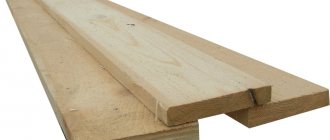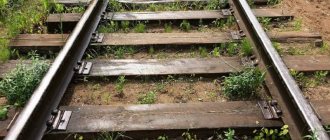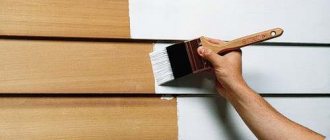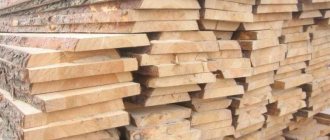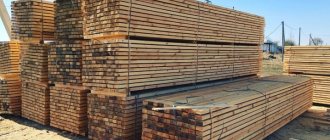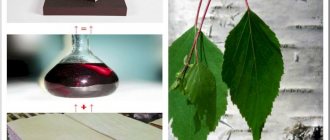The sizes of softwood lumber are regulated by state standards and rules GOST 24454-80. This document applies to edged and unedged materials that are produced for the needs of our country and are also sent for export.
A good master will never order building materials “by eye.” A correctly drawn up estimate for the construction of a house, bathhouse, gazebo and other objects must include the exact amount of lumber. Not everyone will be able to immediately determine how many boards, 6 meters long, are contained in a cube.
A cubic meter is a standard unit of measurement used by all domestic lumber suppliers. If we talk about length, then in addition to footage, you can come across the term “molding”, but this is relevant for the purchase of piece products.
As a rule, boards are not sold in pieces, so you will have to order the required number of cubes. But we need to cover not cubic meters, but square meters, which means we will need to find out the exact number of boards. So how to determine how many pieces will be in one cube?
Helpful information.
Some people ask a very reasonable question - why are boards produced mainly at 6 meters? It's not a matter of the height of the trees, but purely of logistics. Naturally, during the construction of various objects, non-standard lumber may be needed, for example, 7, 8 meters or more. But you will have to pay significantly extra for the delivery of such products, because they can only be loaded onto a road train. Therefore, 6-meter boards are the most common and affordable.
In the calculations below you can see how many lumber with a nominal section of the most popular length of 6 meters fits in 1 cube. It should be noted that the above GOST allows the production and sale of material having dimensions different from those specified in the regulatory document, and in order to calculate their quantity in 1 cubic meter, you must use a simple formula:
n=1/(a*b*c)
, Where
n
– number of boards, beams or beams, pcs;
A
– thickness, m;
b
– width, m;
With
– length, m.
Example
: Let's calculate the number of boards measuring 16x75x6000 mm in 1 m3:
N=1/(0.016*0.075*6)=138.89 pcs
This is a universal formula that is suitable for absolutely any lumber. Thus, the error is reduced to almost zero.
Helpful information.
The sequence of calculations is suitable for absolutely all lumber with flat surfaces. And it doesn’t matter what kind of wood they are made of, the main thing is to know the parameters of each board, beam and lining.
How many tons are in a cube?
Conversion of crushed stone from a cube (1 m3) to tons
| 1 cube of crushed stone | Tons |
| granite crushed stone 20-40 | 1,38 |
| granite crushed stone 40-70 | 1,44 |
| crushed gravel | 1,35 |
| crushed gravel 5-20 | 1,43 |
Interesting materials:
How to reply to messages on WhatsApp? How to respond to a specific message in Direct? How to reply to a comment on Twitter? How to respond to the greeting Assalamu alaikum? How to reply to a message in Aliexpress? How to unlink an account in Clash of Clans? How to unlink mail from mail ru? How to revive the refill of a ballpoint pen? How does paracetamol affect the brain? How to print labels in Word 2010?
Does the mass depend on the moisture level in the material?
The moisture content is the ratio of the weight of water present in wood to its mass. This percentage is always greater than zero, since water is an important part of the tree and is contained in it in a specific amount. The higher the percentage of its content in the tree, the greater the weight of the material. The volume and density of wood depends on this indicator.
As you know, the greatest weight and volume is that of the material that has natural moisture. The concept can be described in the following ways:
1. In the narrow sense. Freshly cut forest has a moisture content ranging from 40 to 110%. Moreover, the percentage depends on the species and season when the tree was cut down. Different parts of the tree have different initial moisture content. Logs from the top are lighter than those from the butt. The moisture percentage of the sapwood is higher than that of the heartwood. As it dries, it levels out in different parts of the trunk to the same state. As a rule, wood with initial moisture weighs several times heavier than dry wood.
2. In a broad sense. This is wood and lumber above the saturation point of the fibers, that is, when a balance of humidity with street air is achieved, and water from the wood stops evaporating. This indicator is different for different breeds and is determined by the temperature regime and the level of atmospheric pressure. For convenience, use the standard indicator specified in GOST - 22%. It follows from this that all materials with a moisture content above this level should be classified as materials with natural moisture.
Lumber with a natural moisture content is popular among consumers due to its availability. Without preliminary drying, they are used extremely rarely, since they shrink and are subject to deformation. Therefore, after purchase, raw wood is dried to the required level of moisture in the composition.
How much does a larch deck board cost?
Larch decking board
| Name | m2 |
| Larch decking board 142x28mm, grade A, 2400 RUR/m2 | Error |
| Larch decking board 142x28mm, grade AB, 2000 RUR/m2 | Error |
| Larch decking board 142x28mm, grade D, 900 RUR/m2 | Error |
| Larch decking board 142x28mm, Prima grade, RUB 2,650/m2 | Error |
Types of rounded logs
All types of logs can be classified as follows:
| Classification feature | Detailing |
| Processing type | – chopped log. In this case, the cylindrical shape is given to the log using a hand plane. They also cut the bowls. This type of log is suitable for those who love the natural style of the Russian hut - log house; – rounded log. Processing is carried out on a rounding machine, due to which ideal geometry and precision of the seats (grooves and bowls) are achieved. |
| Type of drying | – a log of natural moisture. The vast majority of products on the domestic market are of this type. This is due to the fact that it is quite difficult to ensure uniform drying of the original log, and the cost of the product increases; – thermal log or dried round log. Today, manufacturers are mastering the production of an improved product - rounded logs with a given moisture content (18-20%). What it is and its main properties are described below. |
| Type of profile (groove) | – lunar; – Finnish. |
| Wood species (in descending order of popularity and increasing cost) | – pine: Karelian and Arkhangelsk; – spruce; – cedar; – larch; – deciduous species. |
| Groove location | – longitudinal – along the log strictly in the center; – diagonal – used to create non-standard shapes, for example, bay windows; – transverse – landing bowl. |
| Dimensions | – diameter: 160-320 mm; – working height: 139-272 mm. (depending on the diameter of the log); – length: 1...6 m.p.; |
Characteristics of thermal logs
Thermal logs are lumber made from thermally modified logs. The new technology involves heat treatment of wood - high-temperature drying of logs in an airless environment.
Features, properties, pros and cons of thermal logs:
drying at a temperature of 125-190 °C. The choice of temperature depends on the density of the wood;
complete absence of resin. At the same time, coniferous wood retains its aroma;
change at the level of cellular structure. Drying allows you to obtain a log with a given humidity, which eliminates the appearance of blue on the surface of the log. In this case, no chemicals are used;
color correction. Thanks to the effect of heat, varying the exposure time and temperature, the manufacturer has the opportunity to give the wood noble dark shades. In this case, the color change is not end-to-end, i.e. does not affect the entire log, but is deep enough (1-2 cm), which eliminates the appearance of light scratches on the surface of the wall;
decrease in thermal conductivity. After heat treatment, wood loses its ability to transmit heat by 0-30%;
increase in surface strength, which increases the log’s resistance to cracking;
- reduction of hygroscopicity due to modification of its capillary structure;
- no torsion defects;
- resistance to biological activity;
- environmental cleanliness;
- increased durability.
The disadvantage is the high cost.
Lumber Tables
Below are detailed data that will immediately allow you to determine the required amount of lumber from 3 to 6 meters in length. It is very easy to use these tables - we find the required product sizes and see the amount of material and the volume of one element.
Helpful information.
Please note that these tables are approximate results. Doing your own calculations is more accurate. In addition, different manufacturers approach the stacking of lumber in their own way, so the density of the products can vary greatly. Therefore, make a reserve of about 10-20%, otherwise you will have to pay for delivery again.
Table 1.
Number of boards in 1 cubic meter of materials.
Table 2.
Amount of timber in 1 cubic meter of materials.
Table 3.
The amount of lining in 1 cubic meter of materials.
Weight of softwood lumber
The weight of lumber is a variable quantity. It can vary significantly depending on several factors: the condition of the wood, its humidity, and the stage of processing. This indicator can even be affected by the area of the forest in which the trees were cut down, as well as the part of the trunk from which the boards or beams are made.
Table 4
.
Weight of lumber produced from coniferous and deciduous trees
Average weights are shown here. The actual value can vary between 0.7-1.3 from the average.
The influence of density on weight category
Density is another important factor affecting the weight of wood. As a rule, iron and ebony have the highest densities, the values of which vary from 1100 kg/m3 to 1350 kg/m3. Closer figures can be provided by boxwood and bog oak - from 950 kg/m3 to 1100 kg/m3. Before calculating how much a cube of oak, beech, pear or hornbeam boards weighs, you should take into account their density, which is approximately 700 kg/m3. Pine and bamboo have the lowest density - 500 kg/m3, and balsa wood has the lowest density - 140 kg/m3.
Pine weight
In general, softwoods are considered less heavy than hardwoods. In addition, coniferous species are usually easier to process and have a higher resistance to biological factors (due to their resin content). The high demand for pine is also due to the fact that lumber from this tree can be quite long, which is important in some conditions.
Since high-quality wood materials must be well dried, and pine is no exception, we are most interested in the weight of dry wood. The weight of 1 m3 of dry pine will be 500 kg (plus or minus 100 kg). “Dry” pine means material with a moisture content of 10-18%.
By the way, an excessively high weight of wood material may indicate insufficient drying. For example, if the weight of a cubic meter of pine lumber noticeably exceeds 600 kg, it is clearly not dry. Increased humidity of the material may indicate improper storage conditions, which, in turn, can lead to:
- destruction of the internal structure of the tree;
- development of fungus or mold;
- loss of strength properties;
- deterioration in appearance.
The raw material is not recommended for use in construction due to the above hazards and higher shrinkage. Time spent on drying is downtime, which can be avoided by controlling the quality of purchased materials. Including by comparing the actual weight with the standard weight.
Heat transfer from wood
There is another indicator that will allow you to easily determine, for example, how much a cube of dry pine board weighs. This parameter is heat transfer. This indicator is of great importance for those people who use wood as a heating material. It should be noted that thermal conductivity directly depends on the density of the wood species. And the higher the hardness, the higher the thermal conductivity.
Of course, no one will use boxwood as a heating material. However, when choosing between pine or birch, it will be possible to get much more heat if you know which of the species is the hardest. According to the reference tables, you can find out information about the density of each tree.
So, when starting to build a house, you have to deal with nuances that at first glance seem insignificant. However, not all so simple. There are certain indicators that must be taken into account when choosing wood, so as not to make a mistake with the choice and get the desired result from the intended business.
